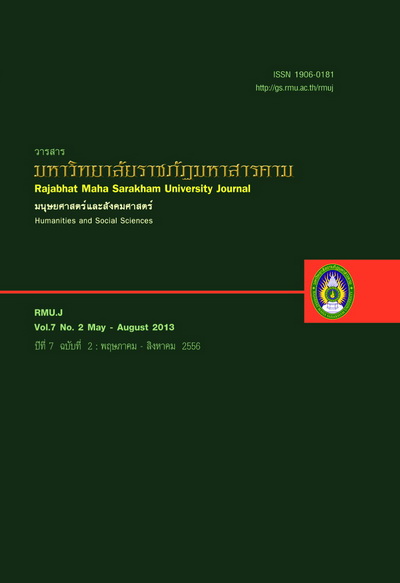การพัฒนารูปแบบการประเมินจิตวิทยาศาสตร์ สำหรับนักเรียน ชั้นประถมศึกษาปีที่ 4-6
Main Article Content
บทคัดย่อ
บทคัดย่อ
การวิจัยครั้งนี้มีวัตถุประสงค์ เพื่อพัฒนารูปแบบการประเมินจิตวิทยาศาสตร์ เพื่อหาคุณภาพของรูปแบบการประเมินจิตวิทยา ศาสตร์ และเพื่อสร้างเกณฑ์ปกติของรูปแบบการประเมินจิตวิทยาศาสตร์ สำหรับนักเรียนระดับชั้นประถมศึกษาปีที่ 4-6 โดยใช้การ วิจัยแบบผสานวิธี มี 2 ขั้นตอนคือขั้นการพัฒนารูปแบบการประเมินจิตวิทยาศาสตร์ และขั้นการหาคุณภาพของรูปแบบ กลุ่มผู้ให้ข้อมูลในขั้นตอนการพัฒนารูปแบบการประเมิน เป็นผู้มีความเชี่ยวชาญด้านการสอนวิทยาศาสตร์ จำนวน 8 คน กลุ่มผู้ให้ข้อมูลเพื่อหาคุณภาพด้านความเหมาะสมและความเป็นไปได้ของรูปแบบเป็นผู้เชี่ยวชาญ จำนวน 5 คน และผู้ให้ข้อมูลเพื่อ หาคุณภาพของรูปแบบด้านความถูกต้องและความเป็นประโยชน์เป็นครูผู้สอนวิทยาศาสตร์ จำนวน 24 คน ที่ทดลองใช้ ในภาคเรียน ที่ 2 ปีการศึกษา 2553 การเก็บรวบรวมข้อมูลเชิงคุณภาพใช้วิธีการสนทนากลุ่ม และการเก็บข้อมูลเชิงปริมาณใช้แบบสอบถามเพื่อหา คุณภาพของรูปแบบ วิเคราะห์ข้อมูลโดยการวิเคราะห์เนื้อหาและสถิติพื้นฐาน ผลการวิจัย พบว่า
1. รูปแบบการประเมินจิตวิทยาศาสตร์สำหรับนักเรียนระดับชั้นประถมศึกษาปีที่ 46 ที่พัฒนาขึ้นประกอบด้วย 4 ส่วน คือ 1) จุดมุ่งหมายของการประเมิน 2) วิธีการประเมิน 3) เครื่องมือที่ใช้ในการประเมิน และ 4) เกณฑ์การประเมิน
2. คุณภาพของรูปแบบการประเมินจิตวิทยาศาสตร์ สำหรับนักเรียนระดับชั้นประถมศึกษาปีที่ 4 6 มีความเหมาะสมใน ระดับมากที่สุด ( = 4.68, S.D. = 0.42) และมีความเป็นไปได้อยู่ในระดับมากที่สุด (
= 4.65, S.D.=0.50) ผลการประเมินคุณภาพ ของรูปแบบ ด้านความถูกต้องครอบคลุมอยู่ในระดับมาก (
= 4.45, S.D.=0.55 ) และมีความเป็นประโยชน์อยู่ในระดับมากที่สุด (
= 4.51,S.D.=0.53)
3. เกณฑ์ปกติของรูปแบบการประเมินจิตวิทยาศาสตร์สำหรับนักเรียนระดับชั้นประถมศึกษาปีที่ 4-6 สังกัดสำนักงานเขต พื้นที่การศึกษาประถมศึกษากาฬสินธุ์ เขต 2 อยู่ในช่วง TC 24 - TC 90 ผลการทดลองจำนวนและร้อยละที่เปรียบเทียบคะแนน จำแนกตามระดับจิตวิทยาศาสตร์พบว่า ระดับจิตวิทยาศาสตร์ของนักเรียนส่วนใหญ่อยู่ในระดับปานกลางร้อยละ 36.91 อยู่ในระดับ ตํ่าร้อยละ 25.15 ระดับสูงร้อยละ 24.54 และระดับสูงมากร้อยละ 13.40
คำสำคัญ : จิตวิทยาศาสตร์
ABSTRACT
This research aimed to develop a model for scientific-mind assessment, to determine its quality, and to establish the norms of the scientific-mind assessment model for 4th - 6th grade students . Mixed methodology was used in this study, which was carried out in 2 phases: 1) developing the model for scientific-mind assessment, and 2) determining the quality of the model.
Informants for the first phase were 8 specialists to give information regarding procedure and steps in teaching science, and 5 specialists to determine the quality of the model in terms of appropriateness and probability; while informants for the second phase were 24 science teachers who implemented the model in the second semester of the academic year 2011 in order to determine its quality in terms of accuracy and usefulness. Qualitative data were collected through use of focus-group discussion while quantitative data were collected by using a questionnaire. The collected data were then analyzed using content analysis and basic statistics. Findings reveal the following:
1. The developed model for scientific-mind assessment consisted of 4 parts: 1) objectives of assessment, 2) assessment methodology, 3) instruments, and 4) assessment criteria.
2. The appropriateness of the scientific-mind assessment model for 6th grade students was found at the highest level ( = 4.68, S.D. = 0.42 ); and its probability was also at the highest level (
= 4.65, S.D.=0.50). The quality in terms of accuracy and coverage of the model was found at the high level (
= 4.45, S.D.=0.55) while its quality in terms of usefulness was determined at the highest level (
= 4.51, S.D.=0.53).
3. The norms of the scientific-mind assessment model for 4th - 6th grade students under Kalasin Office of Primary Education Service Area 2 were determined in the range of TC24 -TC90. Classifying subjects of the study in terms of scientific-mind levels revealed that 36.91 per cent of the students were found at the moderate level, and 25.15 per cent were found at the low level; while 24.54 per cent of them were found at the high level, and 13.40 per cent of the students were found with a very high level of scientific mind.
Keywords : Scientific-mind
Article Details
1. บทความที่ลงตีพิมพ์ทุกเรื่องได้รับการตรวจทางวิชาการโดยผู้ประเมินอิสระ ผู้ทรงคุณวุฒิ (Peer Review) สาขาที่เกี่ยวข้อง อย่างน้อย 3 ท่าน ในรูปแบบ Double blind review
2. ข้อคิดเห็นใด ๆ ของบทความที่ลงตีพิมพ์ในวารสารมหาวิทยาลัยราชภัฏมหาสารคาม นี้เป็นของผู้เขียน คณะผู้จัดทำวารสารไม่จำเป็นต้องเห็นด้วย
3. กองบรรณาธิการวารสารมหาวิทยาลัยราชภัฏมหาสารคาม ไม่สงวนสิทธิ์การคัดลอกแต่ให้อ้างอิงแสดงที่มา


